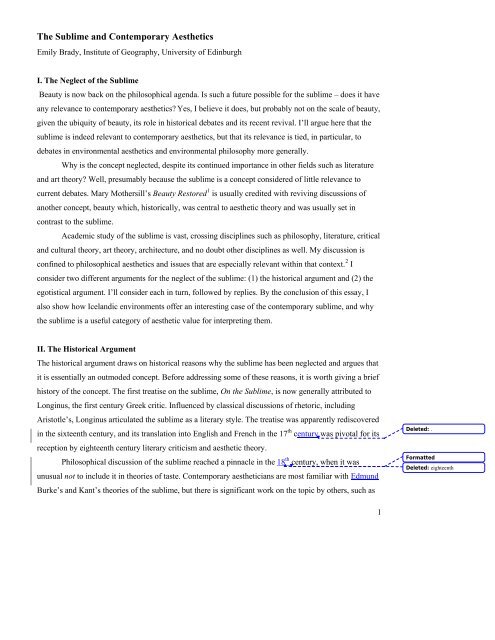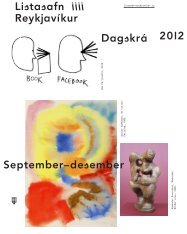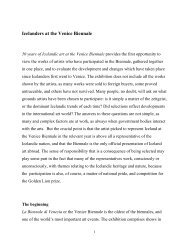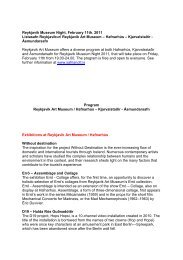The Sublime and Contemporary Aesthetics - Reykjavik Art Museum
The Sublime and Contemporary Aesthetics - Reykjavik Art Museum
The Sublime and Contemporary Aesthetics - Reykjavik Art Museum
Create successful ePaper yourself
Turn your PDF publications into a flip-book with our unique Google optimized e-Paper software.
<strong>The</strong> <strong>Sublime</strong> <strong>and</strong> <strong>Contemporary</strong> <strong>Aesthetics</strong><br />
Emily Brady, Institute of Geography, University of Edinburgh<br />
I. <strong>The</strong> Neglect of the <strong>Sublime</strong><br />
Beauty is now back on the philosophical agenda. Is such a future possible for the sublime – does it have<br />
any relevance to contemporary aesthetics? Yes, I believe it does, but probably not on the scale of beauty,<br />
given the ubiquity of beauty, its role in historical debates <strong>and</strong> its recent revival. I’ll argue here that the<br />
sublime is indeed relevant to contemporary aesthetics, but that its relevance is tied, in particular, to<br />
debates in environmental aesthetics <strong>and</strong> environmental philosophy more generally.<br />
Why is the concept neglected, despite its continued importance in other fields such as literature<br />
<strong>and</strong> art theory? Well, presumably because the sublime is a concept considered of little relevance to<br />
current debates. Mary Mothersill’s Beauty Restored 1 is usually credited with reviving discussions of<br />
another concept, beauty which, historically, was central to aesthetic theory <strong>and</strong> was usually set in<br />
contrast to the sublime.<br />
Academic study of the sublime is vast, crossing disciplines such as philosophy, literature, critical<br />
<strong>and</strong> cultural theory, art theory, architecture, <strong>and</strong> no doubt other disciplines as well. My discussion is<br />
confined to philosophical aesthetics <strong>and</strong> issues that are especially relevant within that context. 2 I<br />
consider two different arguments for the neglect of the sublime: (1) the historical argument <strong>and</strong> (2) the<br />
egotistical argument. I’ll consider each in turn, followed by replies. By the conclusion of this essay, I<br />
also show how Icel<strong>and</strong>ic environments offer an interesting case of the contemporary sublime, <strong>and</strong> why<br />
the sublime is a useful category of aesthetic value for interpreting them.<br />
II. <strong>The</strong> Historical Argument<br />
<strong>The</strong> historical argument draws on historical reasons why the sublime has been neglected <strong>and</strong> argues that<br />
it is essentially an outmoded concept. Before addressing some of these reasons, it is worth giving a brief<br />
history of the concept. <strong>The</strong> first treatise on the sublime, On the <strong>Sublime</strong>, is now generally attributed to<br />
Longinus, the first century Greek critic. Influenced by classical discussions of rhetoric, including<br />
Aristotle’s, Longinus articulated the sublime as a literary style. <strong>The</strong> treatise was apparently rediscovered<br />
in the sixteenth century, <strong>and</strong> its translation into English <strong>and</strong> French in the 17 th century was pivotal for its<br />
reception by eighteenth century literary criticism <strong>and</strong> aesthetic theory.<br />
Philosophical discussion of the sublime reached a pinnacle in the 18 th century, when it was<br />
unusual not to include it in theories of taste. <strong>Contemporary</strong> aestheticians are most familiar with Edmund<br />
Burke’s <strong>and</strong> Kant’s theories of the sublime, but there is significant work on the topic by others, such as<br />
Deleted: .<br />
Formatted<br />
Deleted: eighteenth<br />
1
Addison, Alison, Herder, <strong>and</strong> Mendelssohn. In Burke’s empirical approach, the sublime is attributed to<br />
objects that are great, powerful, vast, infinite, rugged, dark, gloomy, massive, <strong>and</strong> even to loud sounds,<br />
bitter smells <strong>and</strong> stenches. Our feeling of the sublime is an immediately delightful feeling of terror in<br />
response to something dangerous which is distant enough not to cause actual pain. We are completely<br />
overwhelmed by sublime objects: ‘the mind is so entirely filled with its object, that it cannot entertain<br />
any other, nor by consequence reason on that object which employs it.’ 3 Burke <strong>and</strong>, later, Kant argue<br />
that the sublime response may only occur if the spectator experiences the sublime object first-h<strong>and</strong>, <strong>and</strong><br />
when situated in a safe position relative to it.<br />
Kant’s mature theory of the sublime, as it appears in the Critique of the Power of Judgment<br />
(1790) was influenced by Burke <strong>and</strong> earlier theories. However, Kant develops the concept through his<br />
critical <strong>and</strong> transcendental philosophy, <strong>and</strong> his account is distinctive for its focus on nature. 4 Kant<br />
distinguishes between the ‘mathematically sublime’, where the senses <strong>and</strong> imagination are pushed to the<br />
very limits of their powers when confronted by the seemingly infinite magnitude of nature, such as high<br />
mountains or the night sky, <strong>and</strong> the ‘dynamically sublime’, where the awesome power <strong>and</strong> threat of<br />
nature evokes anxious pleasure <strong>and</strong> calls forth an awareness of our distinctive capacities as moral<br />
beings, namely, freedom <strong>and</strong> the power of reason. 5 We feel insignificant <strong>and</strong> powerless in comparison to<br />
the mightiness of nature, yet ultimately we judge ourselves rather than objects sublime as we discover<br />
our own capacity to measure ourselves against nature.<br />
While the sublime was then taken up in Romantic poetry <strong>and</strong> literature <strong>and</strong> in some later<br />
philosophical discussions, it has since not featured as a major category of aesthetic value. <strong>The</strong> historical<br />
reasons for this are no doubt myriad <strong>and</strong> complex, <strong>and</strong> I shall address only a few of them, <strong>and</strong> those<br />
rather speculatively. <strong>The</strong>se reasons are tied to shifts in both the empirical <strong>and</strong> theoretical bases of the<br />
sublime. <strong>The</strong> early development of the concept from its literary to natural treatment, <strong>and</strong> subsequent<br />
celebration by the Romantics, meant that the sublime became deeply associated with natural objects <strong>and</strong><br />
phenomena. Moves away from realistic or naturalistic art <strong>and</strong> towards the expressive <strong>and</strong> avant-garde<br />
led to diminished philosophical interest in aesthetics of nature, including the sublime. <strong>The</strong> sublime has<br />
also been of less interest in art until recently, where it has enjoyed resurgence among artists<br />
<strong>and</strong>philosophers , such as Barnett Newman <strong>and</strong> Jean-Francois Lyotard. 6<br />
Alongside shifts in aesthetic theory <strong>and</strong> the arts lie key changes in aesthetic experiences <strong>and</strong><br />
l<strong>and</strong>scape tastes. Much has been written about how changes in l<strong>and</strong>scape tastes made appreciation of the<br />
sublime possible in the first place, where fear <strong>and</strong> hatred of mountains, deserts <strong>and</strong> other wild places was<br />
replaced with admiration <strong>and</strong> reverence.7F8 <strong>The</strong>se changes in taste were made possible by a number of<br />
2<br />
Deleted: <br />
Deleted:<br />
Deleted: postmodern theorists<br />
Deleted: While these<br />
postmodern accounts have their<br />
own merits, I’m not convinced<br />
that the sublime, as it is best <strong>and</strong><br />
originally understood, applies in<br />
important ways to art. We can<br />
find support for this claim in<br />
Addison <strong>and</strong> Kant – the view<br />
being, briefly, that artworks offer<br />
fewer opportunities for<br />
appreciation of sublime qualities –<br />
overwhelming power or vastness,<br />
terror, etc. Indeed, on many<br />
interpretations of Kant, artifacts<br />
are simply not c<strong>and</strong>idates for the<br />
sublime response.<br />
Deleted: 6 Still, there may be<br />
cases of artifacts – art as well as<br />
technology – which we might<br />
want to call sublime. Some cases<br />
of l<strong>and</strong> art (for example, Michael<br />
Heizer’s earthworks) might<br />
qualify here, or the towering, vast<br />
wind farms of the new energy<br />
l<strong>and</strong>scapes.<br />
Deleted: 7 I don’t have space in<br />
this essay to give a more thorough<br />
defense of my view, but it is a<br />
question worth pursuing in any<br />
new reflections on the sublime.
economic, social, religious <strong>and</strong> technological factors that enabled people to have direct, relatively safe<br />
access to such places. <strong>The</strong>ories of the sublime emerged in line with these changes, where many people –<br />
typically the elite - were in a position to appreciate nature rather than simply fear it or view it as coarse<br />
<strong>and</strong> evil.<br />
Does the current neglect in discourse on the sublime reflect changes in taste <strong>and</strong> experience<br />
away from sublime objects? Has there been a decline in ‘taste’ for the sublime? It could be argued that<br />
opportunities to appreciate the natural sublime have declined, presumably, because many cultures <strong>and</strong><br />
societies are now even less awed by nature, less fearful of it, having developed technological means to<br />
control it, experience real power over it or engage with mountains, the sea <strong>and</strong> other environments in<br />
ways that are now so comfortable that the edgy feeling of the sublime –anxious pleasure – is hardly felt<br />
anymore. In other words, for many societies our relationship to nature has become much less troubled.<br />
<strong>The</strong>re may still be room for neighboring categories of response, such as awe, majesty, <strong>and</strong> wonder, but<br />
not really (it might be claimed) for the complex experience of the sublime, at least if we reply upon an<br />
underst<strong>and</strong>ing of the concept as it was put forward in the 18 th c. So, the main conclusion of the historical<br />
argument is that the sublime is no longer relevant theoretically because those very experiences so<br />
prevalent in the past just no longer exist, or if they exist, they are, in fact, rare.<br />
This conclusion is too swift. <strong>The</strong> access we have to the natural environment does make many of<br />
our experiences, thankfully, safe. But technology has also allowed us to access places that are still wild<br />
to a great extent – huge waterfalls, raging rivers, volcanic eruptions, the vast sea, space, deserts <strong>and</strong> so<br />
on – in ways that still leave room for the sublime response. Although the concept of wilderness is highly<br />
contested, we still have experiences of more or less wild places which offer possibilities for the sublime.<br />
And the sublime need not be limited to remote places – on a clear night, away from light pollution, we<br />
can gaze at that very thing celebrated in Kant’s theory: ‘the starry heavens above’. Granted, the vast<br />
earth can now be examined at our fingertips through Google Earth <strong>and</strong> the like, there are still<br />
opportunities for direct experience of the natural sublime. It is also possible to argue that less<br />
technologically developed societies retain a greater taste for the sublime, but this is becoming much too<br />
speculative – proof would need to found in empirical studies. <strong>The</strong> emergence of extreme sports provides<br />
an example of ways people find risk where it may no longer exist, <strong>and</strong> some small degree of risk (if only<br />
fear ‘incurred in imagination’, as Kant put it), is crucial to any experience of the sublime. I’m not<br />
suggesting that extreme sports are in themselves experiences of the sublime, but they offer opportunities<br />
for aesthetic experience of this kind because of how they situate people in the environment.<br />
<strong>The</strong>se points show that opportunities remain for experiencing objects <strong>and</strong> phenomena commonly<br />
associated with the sublime, thus making our use of the concept still relevant today. But the problem<br />
3
doesn’t end there. If the sublime is to be of interest in an environmental context, then it’s important to<br />
tackle further key objections.<br />
III. <strong>The</strong> Egotistical Argument<br />
<strong>The</strong> egotistical argument stems from the claim that the sublime is inherently egotistical, especially in<br />
terms of the relationship that it sets up between humans <strong>and</strong> nature. <strong>The</strong> first thread of this argument<br />
claims that it is humanity that is valued rather than natural objects, such that the sublime becomes selfregarding.<br />
In many accounts of the sublime, especially those that have been most influential, such as<br />
Kant’s, it is in fact humanity, reason, freedom, moral self-hood that is sublime, not nature itself. Kant<br />
writes ‘what is properly sublime cannot be contained in any sensible form, but concerns only ideas of<br />
reason…’ (CPJ, §23, 5:245).8F9 Through a process of ‘subreption’, we substitute respect for ourselves<br />
with respect for the natural object, or ‘substitution of a respect for the object instead of for the idea of<br />
10<br />
humanity in our subject’ (CPJ, §25, 5:257).9F<br />
Kant’s view is carried into the sublime of Romanticism, <strong>and</strong> it was the poet, John Keats, who<br />
described Wordsworth’s ‘<strong>The</strong> Prelude’ as the ‘egotistical sublime.’10F11 ‘<strong>The</strong> Prelude’, a long<br />
autobiographical poem, is one of Wordsworth’s most famous. Its lines inspire an appreciation of nature<br />
shaped by his loving relationship with the l<strong>and</strong>scapes of his home, the English Lake District. <strong>The</strong>se lines<br />
are from the section referred to as ‘Ice-skating’:<br />
So through the darkness <strong>and</strong> the cold we flew,<br />
And not a voice was idle; with the din<br />
…the precipices rang aloud;<br />
<strong>The</strong> leafless trees <strong>and</strong> every icy crag<br />
12<br />
Tinkled like iron.11F<br />
Although the poetry of Wordsworth <strong>and</strong> other Romantics may reveal a form of respect for<br />
nature, it precipitates the criticism that nature becomes the means to our own self-discovery, a mere<br />
trigger for realizing our place in the world – one that is in fact seen as greater than nature in many ways.<br />
Ronald Hepburn writes that Kant’s theory downgrades ‘nature’s contribution in favor of the one-sided<br />
exalting of the rational subject-self’12F13 <strong>and</strong> ‘the natural, external world may come to be seen as of value<br />
in the sublime experience, only because it can make a person feel the capaciousness of his soul. Intensity<br />
of experience may become the solely prized value.’13F14 Given that the sublime is a type of aesthetic<br />
4
experience – or aesthetic-moral experience – positing nature as other in this way might be seen as a type<br />
of aesthetization of nature indeed even a distorting, humanizing of nature, ‘degrading nature to our<br />
15<br />
measure’.14F<br />
Leading from this, a second thread of the argument is that the sublime posits nature as ‘Other’, an<br />
‘Other’ that is different from ourselves <strong>and</strong> something which we ultimately discover that we have power<br />
over.15F16 In William Cronon’s well known critique of the concept of wilderness, he argues that the<br />
sublime only serves to deepen the separation of humans <strong>and</strong> nature.16F17 <strong>The</strong>re are many other objections<br />
that relate to the egotistical argument, they come from a range of positions – feminist, political, literary,<br />
18<br />
sociological, etc.17F<br />
Let me attempt a reply to the egotistical argument <strong>and</strong> each of these objections. Elsewhere, in a<br />
reassessment of the Kantian sublime <strong>and</strong> aesthetic valuing of nature, I have tried to show that the<br />
Kantian sublime is not as egotistical as these criticisms suggest.18F19 Briefly, rather than reducing sublime<br />
appreciation to awareness of moral vocation, I argue that we cannot overlook Kant’s insistence that<br />
judgments of the sublime fall squarely within the aesthetic domain, <strong>and</strong> as such, natural objects are not<br />
mere triggers of the sublime response, I show how they may be given a proper role in appreciation, even<br />
if the valuing that goes on is indirect. Also, if the distinction between the aesthetic <strong>and</strong> moral in the<br />
Kantian sublime is understood properly, we may discover how this particular type of aesthetic<br />
experience characterizes an aesthetic-moral relationship between humans <strong>and</strong> nature.<br />
Deleted: <strong>The</strong> argument is too<br />
complex to repeat here, but<br />
Deleted: b<br />
In this essay, I’m most interested in trying to defend the more difficult, metaphysical, Kantian<br />
conception of the sublime because I believe it to be truer to the concept as it has developed<br />
philosophically (<strong>and</strong> in relation to the natural sublime). In any case, <strong>and</strong> for the sake of moving my<br />
overall project forward, let me sketch out just why we should care about sublime appreciation of nature.<br />
<strong>The</strong> relationship between humans <strong>and</strong> nature in sublime experience can be seen as involving<br />
elements of both humility <strong>and</strong> self-reflection.19F20 This is not a cozy relationship, rather, it is characterized<br />
by agitation. Many theories of aesthetic appreciation in environmental aesthetics stress the deep<br />
engagement afforded by environmental appreciation as contrasted with many forms of artistic<br />
appreciation <strong>and</strong> scenic or picturesque appreciation.20F21 I agree with these views, <strong>and</strong> I do think the<br />
sublime affords a type of environmental aesthetic experience, but it is not one of the intimate kind. <strong>The</strong><br />
sublime is typified by feeling overwhelmed, anxious, <strong>and</strong> insignificant in the face of crashing waves,<br />
towering cliffs, etc. This is not a delightful or contemplative experience of nature, as we might find in<br />
5
varieties of the beautiful. In this respect, the sublime does not define a relationship of loving nature, or a<br />
friendly one, rather, it is uneasy, uncomfortable, even difficult.<br />
Lyotard’s philosophy enhances our underst<strong>and</strong>ing of how the self relates to environment in<br />
sublime experience. Although mainly interested in the sublime <strong>and</strong> art, Lyotard shows us how the<br />
subject of sublime feeling is de-centered through encounters with the ‘inexpressible’, the<br />
‘unpresentable’ <strong>and</strong> the indeterminate. Discussing the sublime in Barnett Newman’s artworks <strong>and</strong> ideas,<br />
Lyotard writes that, ‘With the occurrence, the will is defeated.’21F22 In the context of nature, we might<br />
synthesize Lyotard’s ideas to interpret the sublime as an overwhelming of the subject, where a<br />
dislocation of the self comes through a sense of nature not fully known, having some element of<br />
mystery; <strong>and</strong> thus nature not appropriated by human reason.22F23<br />
Lyotard interprets Kant’s theory to show<br />
this movement beyond a subject that, ‘feels in the object the presence of something that transcends the<br />
object. <strong>The</strong> mountain peak is a phenomenon that indicates that it is also more than a phenomenon. 23F<br />
Against the egotistical argument, then, Lyotard shows how the sublime signifies a ‘dehumanizing’ of<br />
aesthetic experience, <strong>and</strong> renders a complex relationship between humans <strong>and</strong> nature arising out of an<br />
experience of great affect.<br />
24<br />
IV. <strong>The</strong> <strong>Contemporary</strong> <strong>Sublime</strong> in Icel<strong>and</strong><br />
In sublime experience nature is complex, mysterious, dark, great, huge, towering, vast, disordered,<br />
shapeless, formless, raw, tumultuous, raging, <strong>and</strong> so on. Where do humans fit into this? It’s not<br />
surprising that in true experiences of the sublime we will still feel very small. This doesn’t mean,<br />
however, that nature is somehow grasped as ‘Other’ or as entirely inaccessible to us. We are<br />
appreciating aesthetic qualities of nature of a particular kind. This is what affects us <strong>and</strong> causes the<br />
feeling of insignificance. <strong>The</strong> sublime, then, engenders a relationship that maintains a level of<br />
appreciation – it would not be the sublime if we were so fearful we had to run for safety – but one that<br />
also delineates a particular aesthetic character of environments. This should come as no surprise, given<br />
that the sublime emerged, originally, to cope with the great mountains, waterfalls etc., for which a new<br />
aesthetic taste developed.<br />
This is nature appreciated for qualities that contrast strongly with the mixed environments of<br />
pastoral l<strong>and</strong>scapes. <strong>The</strong>se qualities, while not equivalent to ugliness, belong to a range normally<br />
contrasted with the beautiful. Recent discussions in environmental aesthetics have sought to identify<br />
forms of aesthetic valuing that recognize nature on its own terms rather than merely through the lens of<br />
the picturesque or the scenic, <strong>and</strong> some philosophers have argued for the importance of valuing<br />
6
l<strong>and</strong>scapes commonly thought of as ‘unscenic’. <strong>The</strong> sublime is not necessarily the unscenic, since there<br />
will be overlaps between some varieties of the sublime <strong>and</strong> scenic l<strong>and</strong>scapes, but it is certainly closer to<br />
a ‘terrible beauty’ than a scenic one.<br />
<strong>The</strong> concept of the sublime fits well as a way to characterize Icel<strong>and</strong>ic environments. Many<br />
l<strong>and</strong>scapes in Icel<strong>and</strong> are not conventionally scenic. Vast lava fields, glaciers, barren, treeless<br />
mountains, stunning calderas <strong>and</strong> so on, provide cases of the contemporary sublime, as well as a way to<br />
assign aesthetic value to such environments. <strong>The</strong> wonder of Icel<strong>and</strong>ic l<strong>and</strong>scapes − for someone like<br />
myself who lives closer to the very old highl<strong>and</strong>s of Scotl<strong>and</strong> − is that they are geologically young, <strong>and</strong><br />
highly dynamic. This points to the imaginative component of sublime experience which, evoked by<br />
perceptual qualities such as black s<strong>and</strong>, ice, solid lava, etc., involves a kind of narrative imagining of the<br />
forceful natural processes which have formed the present features of the Icel<strong>and</strong>ic environment. Climate<br />
change means that many of these processes need not be imagined through time at all, given the rapid<br />
changes that are taking place. And, fairly recently for some people, a volcanic eruption (viewed from a<br />
safe place) would be a rare experience of the sublime today. It’s important to remember that although<br />
the sublime is suggestive of the ‘Other’, these l<strong>and</strong>scapes range from the remote highl<strong>and</strong>s to more<br />
familiar regions for many Icel<strong>and</strong>ers.<br />
In conclusion, by replying to the historical <strong>and</strong> egotistical arguments, I hope to have shown that<br />
far from being an outmoded category of aesthetic value, the sublime has contemporary relevance,<br />
distinguishing a valuable <strong>and</strong> distinctive form of aesthetic appreciation of nature. <strong>Sublime</strong> aesthetic<br />
experiences potentially ground an aesthetic-moral relationship which can lead to care <strong>and</strong> respect for the<br />
natural world.<br />
Notes<br />
1 Mothersill, Mary, Beauty Restored (New York: Clarendon Press, 1985).<br />
2 Recent extended work on the sublime in philosophy includes, Paul Crowther, <strong>The</strong> Kantian <strong>Sublime</strong>: From Morality to <strong>Art</strong><br />
(Oxford: Clarendon Press, 1989); Frances Ferguson, Solitude <strong>and</strong> the <strong>Sublime</strong> (New York: Routledge, 1992); Kirk Pillow,<br />
<strong>Sublime</strong> Underst<strong>and</strong>ing: Aesthetic Reflection in Kant <strong>and</strong> Hegel (Cambridge: MIT Press, 2000); James Kirwan, Sublimity<br />
(New York <strong>and</strong> London: Routledge, 2005).<br />
3 Burke, Edmund, A Philosophical Enquiry into the Origin of our Ideas of the <strong>Sublime</strong> <strong>and</strong> Beautiful, ed. Adam Philips<br />
(Oxford, [1757] 1990), p. 53.<br />
4 Commentators differ on this point. I follow Paul Guyer, who argues that Kant is concerned exclusively with nature. See<br />
note 6 below.<br />
5 This distinction can be traced back to Francis Hutcheson. See Kirwan, Sublimity.<br />
8 See Marjorie Hope Nicolson, Mountain Gloom <strong>and</strong> Mountain Glory: <strong>The</strong> Development of the <strong>Aesthetics</strong> of the Infinite (New<br />
York: Norton, 1959); Roderick Nash, Wilderness <strong>and</strong> the American Mind, rev. edn. (New Haven <strong>and</strong> London: Yale<br />
University Press, 1967); Max Oelschlaeger, <strong>The</strong> Idea of Wilderness (New Haven: Yale University Press, 1991).<br />
7
9 All references to Critique of the Power of Judgment (CPJ) with citations referring to section, volume, <strong>and</strong> page number of<br />
the German Academy Edition, Kant’s Gesammelte Schriften, ed. Royal Prussian/German Academy of Sciences (Berlin:<br />
Georg Reimer/Walter de Gruyter: 1900- ).<br />
10 For further remarks in which Kant says it is improper to call nature itself sublime, see CPJ, §28, 5:264; CPJ, §30, 5:280.<br />
11 Hitt, C. ‘Toward an Ecological <strong>Sublime</strong>’, New Literary History, 30:3, 1999, p. 4.<br />
12 William Wordsworth, ‘<strong>The</strong> Prelude’ Book I. In Wordsworth’s Poetical Works, vol. 3, William Knight, ed., 1896<br />
(www.gutenberg.org, accessed 26/10/07).<br />
13 Hepburn, R.W., ‘L<strong>and</strong>scape <strong>and</strong> Metaphysical Imagination’, EV, 5, 1996 , p. 201.<br />
14 Ronald Hepburn, “<strong>The</strong> Concept of the <strong>Sublime</strong>: Has it Any Relevance for Philosophy Today?,” Dialectics <strong>and</strong> Humanism<br />
1-2 (1988), p. 143.<br />
15 Hepburn, ‘Nature Humanised: Nature Respected’, Environmental Values, 7 (1998), p. 277.<br />
16 See Sigridur Thorgeirsdottir’s discussion of Icel<strong>and</strong>ic l<strong>and</strong>scapes <strong>and</strong> nature’s otherness in: ‘Nature’s Wholeness <strong>and</strong><br />
Nature’s Otherness: Aesthetical Aspects of Sustainability.’ In: C-H. Grenholm <strong>and</strong> N. Kamergrauzis, eds. Sustainable<br />
Development <strong>and</strong> Global Ethics. Uppsala Studies in Social Ethics, 33 (Uppsala: Acta Universitatis Upsaliensis, 2007), pp.<br />
51-64.<br />
17 Cronon, W. ‘<strong>The</strong> Trouble with Wilderness; or, Getting Back to the Wrong Kind of Nature’, in Uncommon Ground:<br />
Rethinking the Human Place in Nature, ed. W. Cronon (New York, 1996).<br />
18 See, for example, Kate Soper’s remarks in, ‘Looking at L<strong>and</strong>scape’, Capitalism, Nature, Socialism, 12:2, June 2001, p.<br />
134. Hitt cites several examples from literary criticism, including Eagleton, <strong>and</strong> feminist critics. See Hitt, p. 1. <strong>The</strong>re are<br />
certainly others in feminist philosophy <strong>and</strong> feminist aesthetics, where the sublime is argued to represent masculine power (see<br />
for example, Battersby, C. Gender <strong>and</strong> Genius (Indiana University Press, 1990).<br />
19 Brady, E., ‘Reassessing Aesthetic Appreciation of Nature in the Kantian <strong>Sublime</strong>’, manuscript, 2007.<br />
20 Many writers note this dual respect, including Hepburn (1998) <strong>and</strong> Hitt.<br />
21 See Hepburn, R.W., ‘<strong>Contemporary</strong> <strong>Aesthetics</strong> <strong>and</strong> the Neglect of Natural Beauty’ in Wonder <strong>and</strong> Other Essays<br />
(Edinburgh: Edinburgh University Press, 1984). First published in Bernard Williams <strong>and</strong> Alan Montefiore (eds), British<br />
Analytical Philosophy (London: Routledge <strong>and</strong> Kegan Paul, 1966); Berleant, A. <strong>Aesthetics</strong> of Environment (Philadelphia:<br />
Temple University Press, 1992); Carlson, A. <strong>Aesthetics</strong> <strong>and</strong> the Environment (New York: Routledge, 2000); Brady, E.<br />
<strong>Aesthetics</strong> of the Natural Environment (Edinburgh: Edinburgh University Press, 2003).<br />
22 Lyotard, J-F., ‘<strong>The</strong> <strong>Sublime</strong> <strong>and</strong> the Avant-Garde’. In Benjamin, A., ed. <strong>The</strong> Lyotard Reader (Oxford: Blackwell, 1989), p.<br />
199.<br />
23 In environmental aesthetics, these ideas are similar to Stan Godlovitch’s ‘acentric aesthetic’. See his, ‘Icebreakers:<br />
Environmentalism <strong>and</strong> Natural <strong>Aesthetics</strong>’, Journal of Applied Philosophy, 11:1, 1994, p. 26.<br />
24 See Lyotard, J.F., ‘<strong>The</strong> Communication of <strong>Sublime</strong> Feeling’. In Lessons on the Analytic of the <strong>Sublime</strong>. Trans. Elizabeth<br />
Rottenberg (Stanford University Press, 1994). Reprinted in Crome, K. <strong>and</strong> Williams, J., ed. Lyotard Reader <strong>and</strong> Guide<br />
(Edinburgh: Edinburgh University Press, 2006), p. 260.<br />
8









